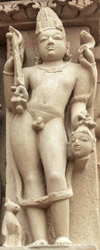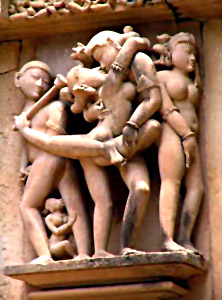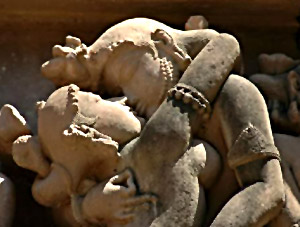 The Kama Sutra or `Aphorisms on Love` by Sanskrit scholar Vatsyayana encompasses approximately one thousand two hundred and fifty slokas or verses, which are divisioned into parts, parts into chapters and chapters into paragraphs. The whole discourse consists of thirty-six chapters, divided into seven parts and sixty-four paragraphs. Kama Sutra is a widely accepted ancient Sanskritic text, acknowledged to be the master amongst all texts in human sexual behaviour.
The Kama Sutra or `Aphorisms on Love` by Sanskrit scholar Vatsyayana encompasses approximately one thousand two hundred and fifty slokas or verses, which are divisioned into parts, parts into chapters and chapters into paragraphs. The whole discourse consists of thirty-six chapters, divided into seven parts and sixty-four paragraphs. Kama Sutra is a widely accepted ancient Sanskritic text, acknowledged to be the master amongst all texts in human sexual behaviour.
The first part or section of Kama Sutra is treated as an introductory to the extensive text, named as Introductory to Kama Sutra. Chapter 1 to this extensive treatise on the art of love is named as `Salutation to Dharma, Artha and Kama`. The initial chapter speaks evidently that the text of Kama Sutra was originally penned by several other litterateurs, like, Swayambhu Manu, Brihaspati and Nandi, corresponding to Dharma, Artha and Kama. The original creations had in the subsequent ages, undergone further makeovers in separate poetic hands. Hence, it had become mandatory for a judicious author who could compile these colossal unobtainable volumes, into a unified one. Thus was Vatsyayana introduced into the state of affairs, who lend his genius brain to shorten Kama Sutra into seven parts, making the treatise decipherable. Chapter 1 to Kama Sutra elucidates about the four basis goals of life, in the meantime speaking about other various aspects of the subsequent chapters.
The second chapter or Chapter 2 of Kama Sutra is titled as `On The Acquisition of Dharma, Artha and Kama`. This chapter mainly lays stress on the observance of the three worldly attainments of Virtue, Wealth and Love, i.e., on the acquisition of Dharma, Artha and Kama. Vatsayana goes on to additionally state that there lies a pre-ordained time for acquisition of each of these domains of humanity. Childhood, one`s youth and old age must be exploited in accomplishing these basic goals of life. However, attention must be rested on the fact that none of these Dharma, Artha and Kama learnings should overlap in any of the life`s fundamental stages.
Chapter 3 to the Introductory of Kama Sutra is titled as `On The Arts and Sciences to be Studied`. The present chapter instructs every human, especially women to study, comprehend and finally assimilate Kama Sutra within one`s bodily system. There rests a very gross notion that the art of love can be mastered under any circumstances, which is indeed untrue. According to Vatsayana, one need must learn the art and science of Kama Sutra, though she is an unmarried maiden. The law and rule of Kama Sutra is not known to any unknowledgeable being, who base their knowledge on mere apprehension. Women, who are already versed in the science of Kama itself, Kama Shastra, must make it customary to apprehend the sixty-four arts of Kama Sutra from somebody senior and married.
Chapter 4 of the Introductory of Kama Sutra is named as `The Life of a Citizen`. The said chapter deals basically with the household life of a man and his daily chores. The man of the household, having acquired the necessary wealth and education in his life, now sheds his attention upon his married phase. Vatsayana describes in a comprehensive manner where precisely the man should have his home, how rooms would it contain and lastly, a phenomenal and meticulous portrayal of the inner and outer rooms.
Chapter 5 of Introductory of Kama Sutra is named as `About the Kinds of Women resorted to by the Citizens, and of Friends and Messengers`. This part of the treatise on the science of love delineates three classes of women as being: maids, women married twice and public women or courtesans. Vatsayana lays down the parameters of the class of women appropriate for sexual union within lower and higher strata of society. Women from higher society, women from low society, women who are still unmarried and hence a virgin, women who already have experienced the pleasure of sexual union are detailed down in chapter 5.




